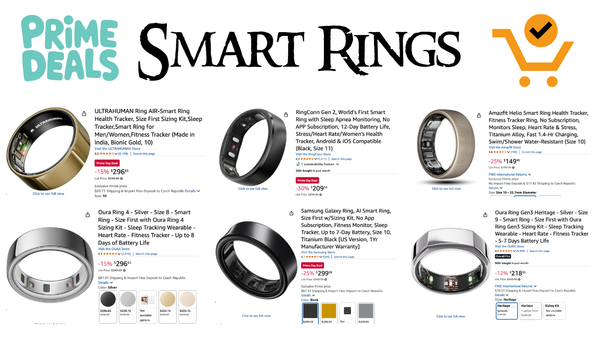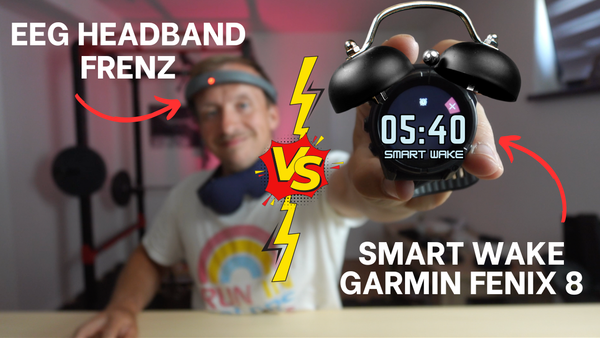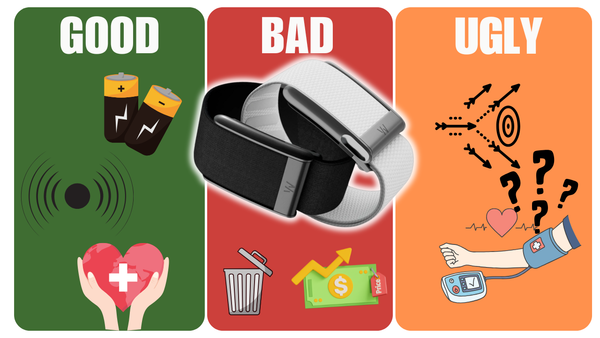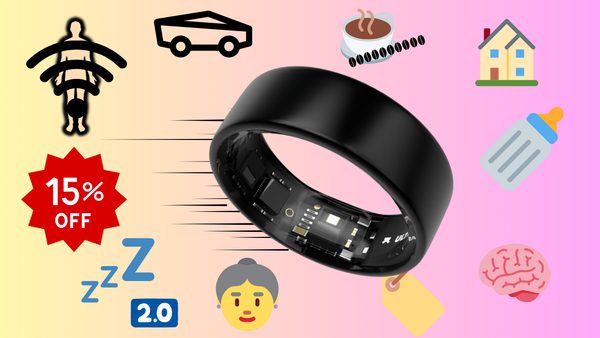Oura Ring 3 — one year later
It’s finally here. Oura Ring 3 is finally released into production, let’s say with some irony. Only now are all the functionalities (some…
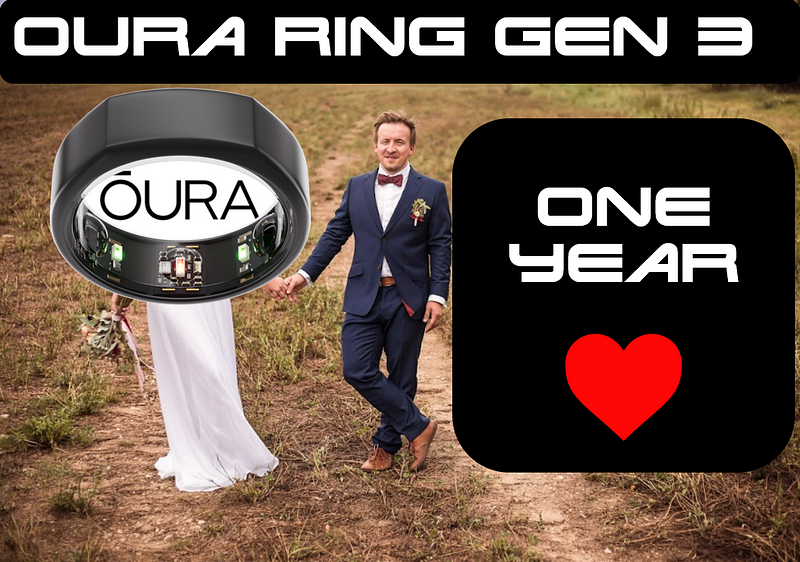
It’s finally here. Oura Ring 3 is finally released into production, let’s say with some irony. Only now are all the functionalities (some still in beta) that distinguished Gen2 and Gen3 deployed.
This is quite funny, considering that some are already out of warranty (users in the US).
It took one long year, and I think I have an idea why Oura Health went down this kickstarter route. It was quite aware that a decent competitive offensive was coming, it needed to quickly release a product that would have the user-demanded daily HR (Heart Rate) and SP02 (Blood Oxygenation) measurements, and it was still more or less alone in the market so that it could afford a somewhat controversial subscription model.
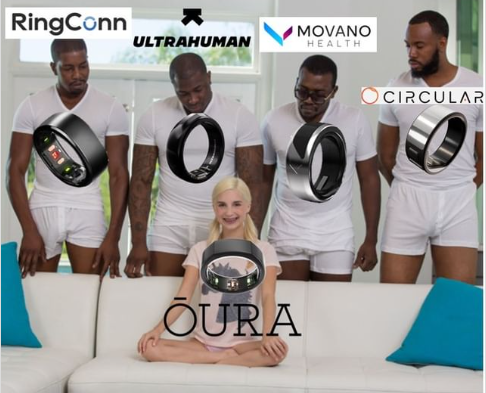
The competition is still miles away from Oura’s level and it is currently impossible to provide a comprehensive real comparison. We can compare mainly paper assumptions, such as in the form of my last comparison focusing on RingConn — here.
If you’ve found yourself here by mistake and don’t know what an Oura ring is, know that it is a wearable electronics, a “smart” ring that collects data about your sleep, activities, measures your heart rate, temperature and movement. And based on that, it makes certain recommendations. The AI already knows this ;-)

This is the video that announced the arrival of the new generation a year ago:
Let’s go through the “new” featuresof Oura Ring 3 again.
GEN3 features
There are 7 or 8 new features if we include the increase in the ring memory size.
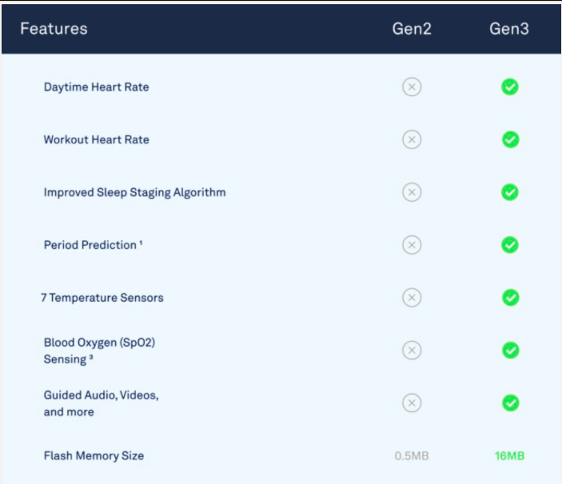
Daytime Heart Rate
This was perhaps the only functionality released directly for GEN3. It was announced at the same time (10/2021) as the new generation itself.
So while the GEN2 was truly a nighttime element with minimal daytime tracking (steps and naps only), the GEN3 can be considered a device that actually makes sense to wear during the day thanks to daytime HR tracking.
My initial thoughts were along the lines of “I don’t need to measure daytime HR with a ring”, I have a watch for that. However, I have to admit that the way Oura has handled the issue is not bad. If we click on the HR section in the app, we get a breakdown into these sections:
- Restorative Time — Resting Time and Rest Time. If it is detected, a comment is also displayed.
- Sleeping — HR during sleep, this was the de facto functionality of GEN2, but in this section it is supplemented for GEN3 with an interesting info-graphic, I will elaborate below.
- Workouts — I’ll get more into this under Workout HR.
- Daytime — daily HR tracking, shows a daily trend rather than 100% HR over the course of the day (it’s scanned every 5 minutes), it’s not always able to measure it, e.g. if you’re too active (and don’t use Workout HR) it may show “gaps”. The measurement can be activated manually by clicking on 💗.
Educational part
What I like are the patterns that you can read more about by clicking “Learn more” for Sleeping and Daytime. You can easily compare your HR curve with the pattern and learn more e.g. if your nighttime HR has a shape rather:
- The Hammock — indicating an optimal curve,
- The Hill — indicating signs of exhaustion,
- The Downhill Slope — indicating an overworked metabolism,
- The Uplands — indicating a lack of rest.
To illustrate one hammock below and more on the issue can be found on the Oura blog.
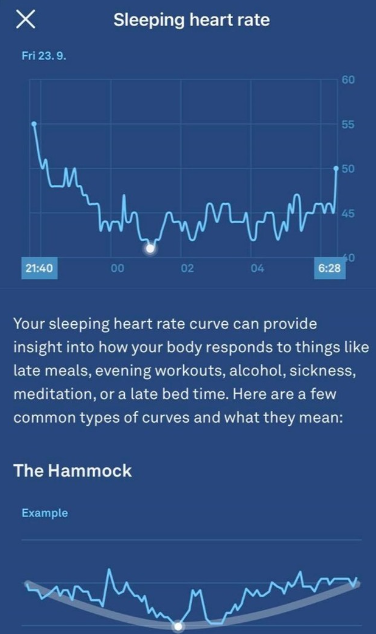
Similar is the case for daily HR with the following shapes:
- The Camel — which characterizes a natural rhythm where we are more active in the morning, with a little rest after lunch followed by a more active afternoon and preparation for sleep.
- The Bridge — most activity in the morning and mid-morning, gradual decline and preparation for sleep.
- The Mountain Range — indicating a busy day, high performance, and stress.
- The Open Ocean — represents a relaxing course of the day, with no stress.
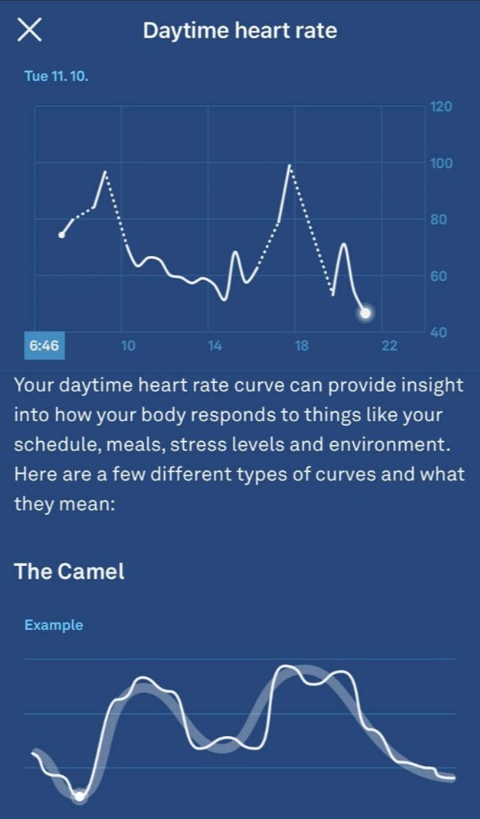
Oura doesn’t currently tell by itself what pattern is closest, but I’m sure the shape of the curve enters into the calculation of the sleep or readiness contributors.
Workout Heart Rate
This feature was released on 05/2022.
To be honest, I only used this functionality while writing this article. I have two reasons for this:
- I see the Oura ring as a passive data collector. Workout HR requires initialization (and also deactivation) from the app. To explain, the difference between Daily HR and Workout HR is due to the frequency of sensing, Workout HR senses the ring more often and is thus more accurate (and also of course more energy-eating).
- For heart rate measurement, a simple rule works, the closer to the heart the better. If you really want to measure your heart rate accurately, there are better tools available, some watches and especially chest bands. This is confirmed by the QuantifiedScientist test, see below:
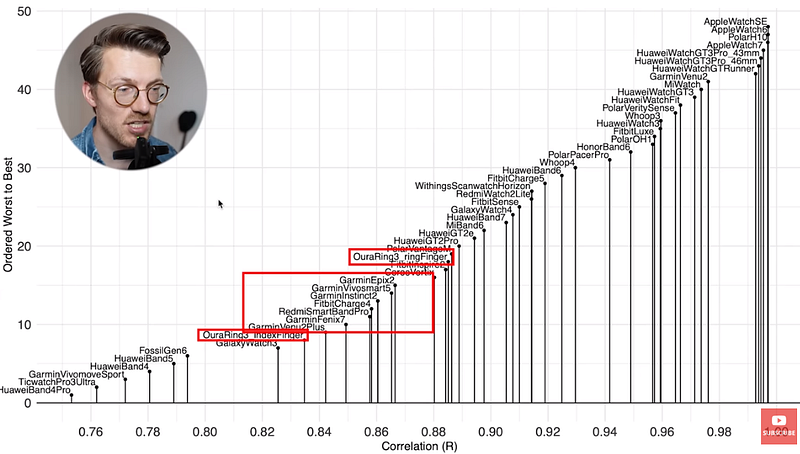
It’s a big surprise that some leading watches such as Garmin finished behind the Oura ring in his test.
Unless you’re using another tracker, it’s obviously an interesting functionality given the more exact data regarding activities (the choices are currently walking, running/biking indoors and outdoors).
Improved Sleep Staging Algorithm
This is the functionality I was most excited about, and it comes last in line (in beta). This is because it may bring users more accurate detection of sleep phases and therefore more relevance of data in sleep tests.
The algorithm is probably the biggest alchemy of the whole GEN3, because sleep happens mainly in the head and distinguishing sleep phases by reading data from the finger is simply a nut to crack. This is also why I think Oura should dominate this category due to its years of a head start and giant sleep dataset.
Interestingly, the above announcement cites as background the scientific publication The Promise of Sleep: A Multi-Sensor Approach for Accurate Sleep Stage Detection Using the Oura Ring, which was published back in 2021 and is backed by, among others, Dr. Marco Altini, founder of HRV4Training.
Oura breaks the issue down into two categories:
- 2-phase (wake/sleep) — i.e. the pure distinction between wakefulness and sleep. The aim is to achieve a 96% success rate.
- 4-phase (wake, light, deep, REM) — i.e. the determination of sleep phases. Here Oura achieved 79% agreement compared to the gold standard, polysomnography.
Accelerometer, temperature, HRV and “circadian features” enter the machine learning model, that determines sleep phases. The circadian features contributed to a 3% improvement in the model. According to the above work, these are mathematical functions independent of the sensor data. Specifically, they are the cosine function, the exponential decay, and the linear function.
The first is to reflect circadian rhythm, the second the homeostatic “sleep pressure” and the third is to account for the known asymmetry of sleep phases across a typical sleep night (i.e. more deep NREM at the beginning of the night and more REM sleep in the last hours of the night).
During the beta, the new algorithm is presented as an independent output of the application, i.e. it does not enter into the calculations of Sleep score, Readiness, etc.
I have to say that from the first few nights when I have the opportunity to switch to the new Beta version of the algorithm, I am a bit confused when comparing it to the Dreem2 EEG reference device. I don’t think it’s currently possible to extract the hard hypnogram data from the Oura, so I’m only comparing the waveforms and total sleep phase values, see below for the current algorithm vs beta vs reference Dreem2 EEG.
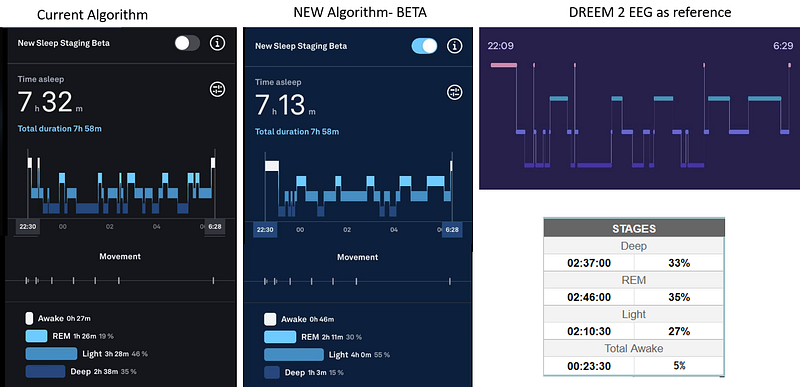
I would say that the curve of Beta’s hypnogram is closer to the reference, e.g. with respect to the segmentation of the phases. But unfortunately, the overall phase times are rather less accurate, which is most demonstrated by the deep sleep — actual 35 %, beta 15 % and reference 33 %. Of course, it’s probably not entirely fair to compare the theoretical value from the study — 76% accuracy — and one night within the beta. However, so far I’m rather disappointed with such variance.
Period Prediction
Menstrual cycle prediction is currently one of the functionalities in which Oura is currently unique in the smart ring segment. It was released on 10/2022, having been tested for several months as part of the BETA version.
Since I can’t test this functionality, I have searched for information mainly on various forums and my impression is that the prediction is rather confusing, predicts very inaccurately and rather requires manual input. At the same time, however, it has sparked a debate about data security and privacy, which is certainly correct.
This functionality should be followed by a “pregnancy mode” in the future.
7 Temperature sensors
The 7 temperature sensors are a HW issue and have been part of GEN3 from the beginning (GEN2 has 3 sensors). I honestly couldn’t tell any difference when comparing data from both generations.
However, this improved temperature sensor system should serve the primary purpose of period prediction and also the ability to detect impending disease.
Blood Oxygen (SP02) Sensing
Blood Oxygen Saturation Measurement (SP02) was released on 07/2022.
At the output, i.e. in the application, it breaks down into two metrics:
- Average oxygenation saturation in % — by default the value should be in the 95–100% range, Oura itself says that if the value is regularly above 95%, there is no need to check it daily (and I might consider turning it off in the settings, which saves battery).
- Breathing regularity — shown on the graph if detected.
Both metrics are currently measured in sleep longer than 3 hours. It is unfortunate that Oura does not allow SP02 measurements during the day. It might be useful to monitor this value during breathing exercises, or moving at higher altitudes for example.
Guided Audio, Videos, and more
This is the de facto “Explore” tab, in which various meditative/breathing exercises can be found, with various metrics (temperature trend, HRV, HR) measured in relation to the length of the session. The Explore is divided into 4 sections — Meditation, Breath, Sleep, and an educational “Learn” passage.
I see this library of various exercises, listening sessions, etc. as really premium, as you would pay for them in other apps, such as Headspace. Plus, in the Oura app you get immediate feedback in the form of the metrics mentioned above.
Oura provides this functionality in cooperation with Doze, Oak and Yogaia.
Flash memory Size
The ring’s internal memory has increased, especially in light of the more data the ring measures. Pretty much an irrelevant issue for users, as Oura still recommends syncing data with the app daily, or at least weekly.
Other findings
In the year that I have been using the GEN3 Oura ring (previously I used GEN2 for 2.5 years), I have noted additional insights beyond the 7 core features.
Changing daily goal
One of the slightly hidden newer functionalities is the ability to edit the daily goal and also its form. Oura defaults to calculating the daily goal in calories, now there is an option in the app to decrease/increase it and also change it to number of steps. More is described here.
New Oura products
Two new products have been released in the last year. The Gucci x Oura ring is a snobby affair, and the Horizon version is the most rounded version, for which you pay about 50 EUR more than the standard Heritage in basic colors. It is also obvious that Oura is targeting women more, as a new color variant Rose Gold has been added, just in the form of Horizon, which is already attacking 600 EUR. For my taste, too much emphasis on profit…
Batteries
The battery has been a much-discussed topic on many forums especially after the release of the SP02 when there was a subsequent significant drop in ring battery life for many. I think the situation has subsequently stabilized with additional firmware.
My routine is to charge the ring roughly every other day, however, I have an experience where during my hiking through Greece the battery was at 19% after 5 days with SP02 and Airplane mode enabled.
Reports
While the weekly and monthly reports have been in the app for a long time and leave me rather cold or are not very graphically attractive, the quarterly reports have been added relatively recently and are very nicely done — see example.
I think these reports provide better insights into the past period and outline trends that are perhaps more significant than data from individual days and weeks. This brings us to trends.
Trends
Trends are not new functionality, but they are something I would like to pick up here. In fact, my approach to the data that Oura provides has changed in this regard as well. Whereas before I was almost hungry every morning for data, what was my sleep like then, I am now more aware that the goal is the consistency of quality sleep or continuous improvement. I’m adding some of my trends below for illustration.
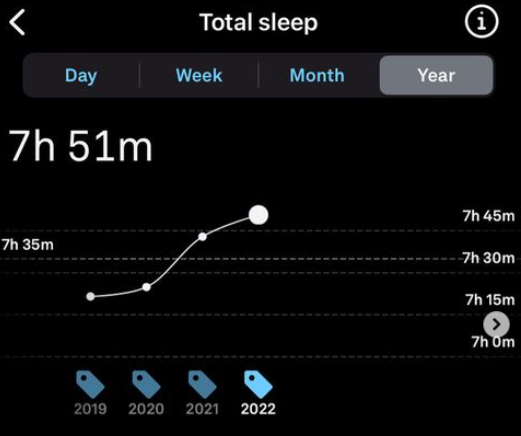
Conclusion
The Oura ring GEN3 is still the absolute top in its narrow segment of rings that monitor vital signs. It is characterized by its very high-quality HW processing, very clear application, and consistency of measured data quality.
Oura Health is continuously working on the development of this product, in fact, they don’t have much left, considering that last year they started selling the ring “with promise”.
Honestly and in hindsight, I’m glad I got the GEN3, it still provides interesting feedback and insight into my health and sleep hygiene. Also, pragmatically, due to my previous ownership of GEN2, the subscription model is a lifetime premium for me. At the same time, I add that I think it’s a good thing that competing products are coming along, some of which I’ve already discussed or dissected. Their reviews on this blog will probably not be missed.
Links below if you are planning to purchase some rings (some may more or less reward me, thanks):
OURA 3–50 EUR DISCOUNT — https://fitnesator.link/oura
CIRCULAR RING 8% DISCOUNT — https://fitnesator.link/circular
RINGCONN — https://fitnesator.link/ringconn
ULTRAHUMAN — https://fitnesator.link/ultrahuman
